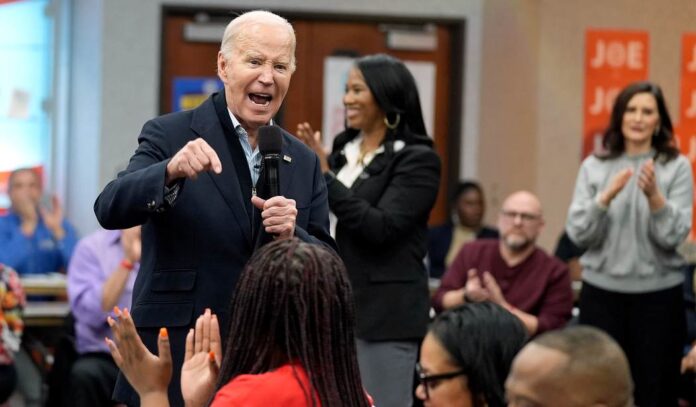Last year, in the middle of the historic UAW strike that ended up closing plants of General Motors, Ford, and Stellantis (Chrysler) for a month and a half, it was discussed openly here in Detroit that this new strategy adopted by the newly elected UAW leadership could be a bit risky. The strike dragged on for about a month and a half and eventually, all three automakers struck a deal that seemed to make everybody happy, so in theory, the strategy worked.
Particularly Democrats who hailed it as a new era for union membership and a win for blue-collar workers everywhere and who traditionally have unions and those workers who support them blindly.
Now it looks like their victory lap may have been premature, and the happiness may not last long-term.
Since those deals were struck last October, I have started to hear grumblings that the rank and file are not as happy as they were possibly at first because of the devil in the details that they were sold on at the time. Particularly the members who do not have seniority, which guarantees them many things they thought they were going to receive.
Then came this news yesterday which validated some of those concerns I heard about previously .
A year ago, the United Auto Workers was bragging about adding 10,000 members, with the union saying it was “just getting started.” The later held an unprecedented strike, shutting down production for several American automotive plants in a move that led to higher wages and benefits for many auto workers.
But auto companies announced several rounds of layoffs since then, and they have severely cut back on vehicle sale projections, especially for electric vehicles.
Recently released federal filings with the U.S. Department of Labor show that the union’s total membership is at its lowest since 2010, during the depths of the national Great Recession and at the end of Michigan’s economic “Lost Decade.”
The UAW is down to 370,239 active, dues-paying members, a drop of approximately13,000 from last year. The union had more than 700,000 active members in 2002 before bottoming out at around 355,191 in 2010. This hasn’t hurt the union’s revenue, however. It took in $485 million last year, the most ever.
Yikes.
So you were planning on adding 10,000 members last year and lost 13,000 here in Michigan and beyond. UAW President Shawn Fain and the boys down at Solidarity House in Detroit might need to apply for government jobs with performance numbers like that.
Also, you lose members but take in more money; I wonder how they did that?
Just thinking aloud.
Seems as though those who started grumbling after the deals were struck may have been on to something, and it’s resulting in the automotive companies being able to shed UAW members.
I recalled this article right after the strikes were over.
Reasons behind the disapproval vary, according to industry experts and UAW members who spoke with CNBC. Veteran workers are worried about not receiving as much as newer employees under the terms of the deals, including retirement benefits. They’re also concerned about language in the tentative agreements. There’s also lingering distrust in union leadership after past corruption scandals of former leaders.
Others cite inflated expectations from UAW President Shawn Fain regarding 40% pay increases, traditional pensions and retiree health care for all, the elimination of “tiers” and a 32-hour workweek.
“I don’t think the tentative agreement goes far enough. I think it’s divisive. It doesn’t get rid of the tiers, and it doesn’t meet all of our needs as a whole,” said Brian Keller, a former UAW presidential candidate in several past elections and an outspoken worker from Stellantis’ Mopar parts operations. “You got to remember, we were stagnant from the time of the bankruptcy to 2015. We didn’t get no wage increases.”
In a post I did in September of 2023 before the strikes hit, I touched on the fact that the UAW and their leadership were backing an administration that wanted to cut their membership, according to one analyst, by 40 percent.
When I read this piece here and looked at some of the numbers of how many jobs would be lost to the transition to electric vehicles I was amazed that the union leadership even gives a dime to the Democrats.
President Joe Biden praised General Motors chief executive Mary Barra at a 2022 event, saying “we owe you big” for pushing the auto industry towards all-electric production over the next decade. The president’s kind words for Barra, and their decision to team up to back a transition to electric vehicles, could come back to haunt both parties amid a historic United Auto Workers strike.
The 150,000-member union has singled out Barra as an example of corporate greed at the “Big Three” automakers, a group that also includes Ford and Stellantis. UAW, which launched a strike at four auto plants last week, took a shot at Barra over her industry-leading $29 million annual salary. UAW president Shawn Fain declared “war” on the Big Three last month, citing the $200 million Barra has raked in over the past decade. The union wants a hefty increase to salaries and benefits for its members, along with assurances that jobs will be protected during the transition to EV production.
That dramatic shift will likely come at a steep cost in terms of auto industry jobs, and the transition to electric vehicles is at the center of the auto workers’ complaints. According to one estimate, the transition to EV production will come at the cost of 117,000 auto jobs.
I bet Fain and Bara are all cozy now, dreaming of new ways to create electric vehicles and screw the UAW workers.
So once again, instead of adding 10,000 jobs as Fain predicted, the UAW lost 13,000.
This news has some problems for the leadership of the union and the Democratic Party.
Michigan, of course, is the home of the big three, and we pretty much put the world on wheels here, so the vast majority of those people who work in the factories in this state take a certain pride in that.
The other thing is the UAW leadership has never been shy about saying that they’re the happy bunkmates of Democrats, endorsing them, supporting them with union dues, and allowing the party to run roughshod right over them while supporting and pushing energy policies that will cut UAW jobs.
Truly, it’s a political inbred situation.
There may be “Hope and Change” in the air this election cycle as my colleague Nick Arama wrote last week that polling shows in the swing states Biden won against Trump in 2020, Sleepy Joe is currently behind now.
From that post.
I touched on a new Wall Street Journal poll in my story about Jill Biden snapping at a CBS reporter over how badly Biden is doing in the battleground states.
But the bottom line is she can’t spin or argue away the facts, even though she just spread some absolute malarkey about how Biden was “even or better” in the battleground states. Indeed as the new poll shows, former President Donald Trump is leading in six of the seven states.
Donald Trump is leading President Biden in six of the seven most competitive states in the 2024 election, propelled by broad voter dissatisfaction with the national economy and deep doubts about Biden’s capabilities and job performance, a new Wall Street Journal poll finds.
The poll of the election’s main battlegrounds shows Trump holding leads of between 2 and 8 percentage points in six states—Pennsylvania, Michigan, Arizona, Georgia, Nevada and North Carolina—on a test ballot that includes third-party and independent candidates. Trump holds similar leads when voters are asked to choose only between him and Biden.
The one outlier is Wisconsin, where Biden leads by 3 points on the multiple-candidate ballot, and where the two candidates are tied in a head-to-head matchup.
If Shawn Fain and his cohorts continue to allow the UAW to be abused politically by Democrats as they have been for the past 30 years, Donald Trump will be the least of your problems.
Your continued declining membership will be paramount.
Plus, your butt hitting the street after your members toss you out.




